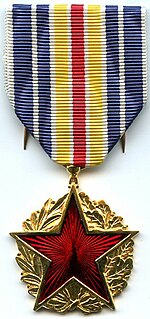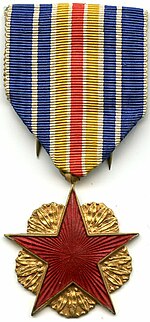Medal for the War Wounded

| Medal for the War Wounded | |
|---|---|
 Obverse | |
| Type | State award |
| Awarded for | Injury sustained in combat |
| Presented by | |
| Eligibility | Members of the French Armed Forces, French nationals |
| Status | Active |
| First awarded | 17 August 2016 |
Ribbon of the award bearing a single wound star | |
| Precedence | |
| Next (higher) | Médaille de la Gendarmerie nationale[1] |
| Next (lower) | Resistance Medal[1] |
The Medal for the War Wounded (French: Médaille des blessés de guerre) was originally a mere insignia in the form of an ribbon awarded for wounds received in the line of duty while facing an enemy. The insignia was established by the law of 11 December 1916,[2] based on an idea by the nationalist writer Maurice Barrès. Although originally established as a temporary measure, the insignia survived for a century in some form or another. It could be awarded to wounded soldiers, prisoners of war, to World War II deportees and internees from the French resistance and to soldiers wounded in more recent conflicts.[3] A variety of unofficial medals in the form of a red enamelled star suspended by the same ribbon appeared very early on and although tolerated for wear by the authorities, were not official until recently.
A provisional instruction of 14 April 2015[4] from the French Army High Command began the proceedings which were later ratified in the official decree n° 2016-1130 of 17 August 2016 making the Medal for the War Wounded a state decoration of the French Republic.[5] A recent 2017 amendment further simplified the regulations of this award by allowing all past recipients to keep wearing it but strictly limiting any future award to military personnel.[6]
Statute
[edit]The Medal for the War Wounded can be worn by:
- Military personnel suffering from a physical or mental war wound, ascertained by the army health service and approved by the Minister of Defence;[5][6]
- Prisoners of war, physically or psychologically wounded during their detention.[5][6]
Article 3 of the new regulation states that the wear of this medal is not subordinate to an official ceremony of award.[5][6]
Article 4 of the new regulation further states that persons who were eligible for and wore the now defunct insignia as mentioned in Article 2 of the now abrogated 1952 law[7] governing its wear (resistance deportees and internees), may wear the medal.[5][6]
Award description
[edit]The Medal for the War Wounded is made of gilded bronze with a 30 mm diameter. It is mainly composed of a large bright red enamelled five pointed star atop a crown of half laurels (left) and half oak leaves (right).[5][6]
The medal is suspended by a ring from a 35 mm wide silk moiré ribbon composed of vertical stripes in the following colours: white 1 mm - blue 5 mm - white 1 mm - blue 4 mm - white 1 mm - yellow 3 mm - white 1 mm - beginning ou the outer edge on both sides of a 3 mm wide central red stripe.[5][6]
Small enamel red five pointed stars are added to the medal ribbon and undress ribbon for each additional wound.[5][6]
| Unofficial medal early variant set in starburst | Indochina medal correctly bearing the old insignia |
|---|---|
 |  |
Notable recipients (partial list)
[edit]
- Sergeant André Maginot
- General Pierre Billotte
- Major Hélie de Saint Marc
- General Raoul Salan
- Resistance fighter André Girard
- General Edgard de Larminat
- Foreign Legion Captain John Freeman "Jack" Hasey
- Lieutenant-Colonel Pierre Clostermann
- Sergeant Eugene Bullard
- Captain Pierre-Eugène Fournier
- General Gilbert Henry
- Lieutenant Jean Carrelet de Loisy
- Major Jean-Edmond Lamaze
- Lieutenant-Colonel Alfred Maurice Cazaud
- Lieutenant-Colonel Jean Vérines
- General Félix de Vial
See also
[edit]References
[edit]- ^ a b "The national system". Grand Chancery of the Legion of Honor. Retrieved 15 May 2023.
- ^ "CIRCULAIRE N° 24950 K of 11 December 1916" (in French). Marc Champenois. Retrieved 2016-11-14.
- ^ Battini, Jean; Zaniewicki, Witold (2003). Guide pratique des décorations françaises actuelles. Paris: LAVAUZELLE. pp. 29–36. ISBN 2-7025-1030-2.
- ^ "INSTRUCTION PROVISOIRE N° 1403 of 14 April 2015" (in French). Marc Champenois. Retrieved 2016-11-14.
- ^ a b c d e f g h "Decree n° 2016-1130 of 14 April 2015" (in French). Legifrance. 19 August 2016. Retrieved 2016-11-14.
- ^ a b c d e f g h "1 January 2017 amendment to Decree n° 2016-1130 of 14 April 2015" (in French). Legifrance. 1 January 2017. Retrieved 2017-01-04.
- ^ "Law n° 52-1224 of 8 November 1952" (in French). Marc Champenois. Retrieved 2016-11-14.